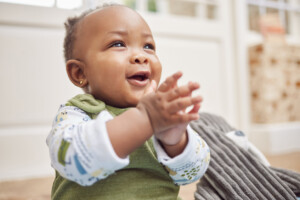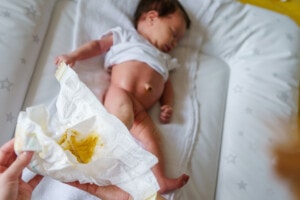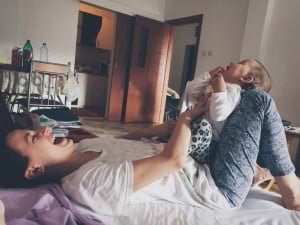The appearance of your baby’s teeth is an exciting milestone. You’ll start to see their gummy smile turn into a little toothy grin! But when exactly should you expect those pearly whites to start appearing? In this article, we’ll walk you through your baby’s teething chart and explain which teeth will arrive first and how soon the others will follow.
Baby Teeth Eruption Timeline


Here’s a timeline of when your baby’s teeth will come in:
Central Incisors
The lower front two teeth are usually the first to make a shining debut between 6 and 10 months of age. The top two incisors follow in quick succession, often between 8 and 12 months.1
Lateral Incisors
The upper lateral incisors erupt with one on either side of the central incisors. These make an appearance when your baby is between 9 and 13 months old. The lower laterals follow the uppers at 10-16 months.1
First Molars
The upper first molars appear between 13 and 19 months old, one on either side of the jaw, followed by the lower first molars between 14 and 18 months. These teeth help your baby to chew more substantial food.2,4 Until then, babies mostly use their gums to mash food.3,4
Canines
Next in line are the canines, also known as the cuspids. They emerge after the first molars have made an appearance. The upper canines usually erupt between 16 and 22 months of age, while the lowers surface by 17-23 months.1 These teeth fill the space between the lateral incisors and the first molars, giving your little one a more evolved smile.
Second Molars
These are the last of the baby teeth to surface in the jaw. They emerge behind the first molars, usually between 23 and 31 months of age in the lower jaw and between 25 and 33 months in the upper. And by age 3, most kids will have a complete set of 20 primary teeth.1
11 “Toothy Truths” About Your Baby’s Teeth
Here are several “toothy truths” that all moms should know about their baby’s teeth:
- Your nutrition can impact your baby’s teeth. The development of baby teeth begins during the sixth week of gestation.5 Your diet should have adequate amounts of calcium, phosphorus, vitamin D, and vitamin C to assist the growth of your child’s teeth and bones.5,6
- Their jaw is still growing. A baby’s jaw is almost 50% of its adult size at birth. It reaches 80% of its adult size by the age of 6 years.7
- Teething charts are general guidelines. It’s important to remember that every baby is unique. Some children may get their first teeth earlier, while others may get them later. If the first tooth’s appearance is not evident by 18 months of age, it’s time to check with your health professional and make sure everything is okay.8
- Tooth development is hereditary. If you, the parent, got your teeth a little early or late, chances are your baby will too.9,10
- Their teeth might not come in the typical order. Teething may not always happen in the same order as the “norm.” So, don’t get anxious if your child’s teeth appear in a slightly different sequence.10,11
- A baby girl will likely have her teeth come in before a baby boy. Girls tend to develop teeth earlier than boys of the same age.5
- You’ll need to clean their teeth regularly. As soon as your child’s first tooth erupts, you’ll need to get into the habit of cleaning them.8
- Enjoy those pearly whites! Your child’s smile is the brightest it will ever be, as baby teeth are whiter than permanent teeth.12
- It’s normal for baby teeth to have spaces or gaps.13 There’s a noticeable space between the lateral incisor and the canine in the upper jaw, while in the lower jaw, it lies between the canine and the first molar. Baby teeth preserve this space for permanent teeth and guide them into their correct positions.14
- Baby teeth help with speech development. Baby teeth provide proper contact points for the tongue and enable your child to form words. Thus, they play a vital role in speech development.1,15
- Your child will begin losing their baby teeth around age 6. The first teeth to shed are usually the central incisors. You would notice the appearance of the permanent first molars around the same time.16,17 The last primary tooth is lost at age 12 and is either the canine or the second molar.17
We hope this article gave you a better idea of what to look for as your baby’s teeth start to emerge. Get ready to see their beautiful smile grow in the coming months!



































